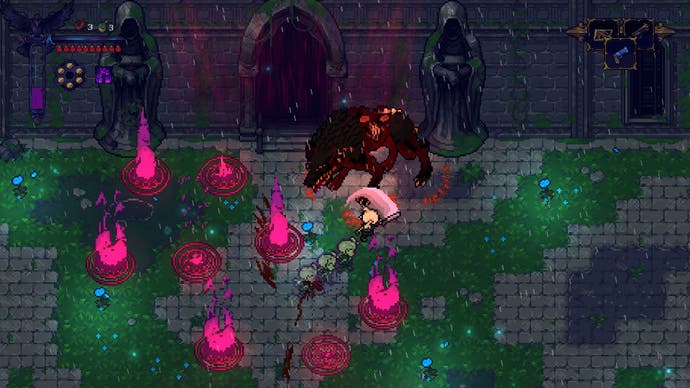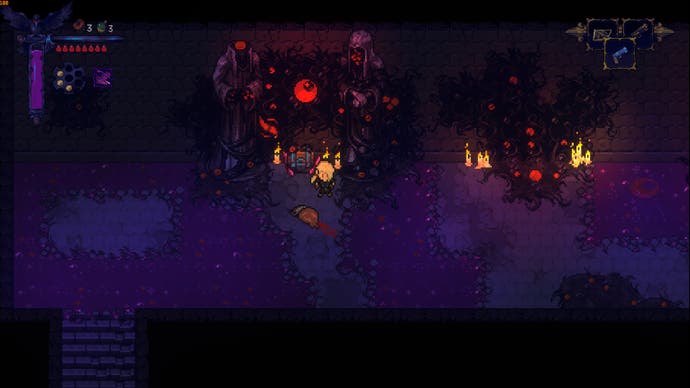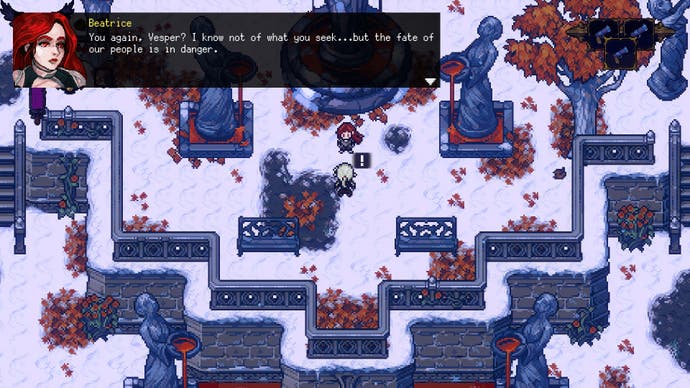A mix of sinister pixel art with the vibes of a mean Zelda and the tar-black, sadistic soul of a Bloodborne – that sounds like an interesting melange, and not only to me. A sure-fire success actually – and yet I had enormous difficulties getting into Hunt the Night. In fact, I gritted my teeth on it for a good four hours, barely making any progress and was about to give up. Strictly speaking, it wasn’t fun at the beginning.
And then… yes, then all of a sudden things got better. I’m still not convinced that the combat system is technically good. And that’s primarily because it’s uncomfortably wedged between the two models above and can’t quite decide between a methodical, wait-and-see fight and nimble pixel art slits. “Clunky” would be a word that comes to mind – solid elements that don’t really make a very catchy overall picture in practice.
It starts with an evasive dash of “i-frames” (animated phases where you’re briefly invincible) that’s so long that it regularly sends me falling to my doom, while also not interrupting my own attacks, so not all the time is available. In addition, a strangely imprecise hitbox for my heroine, the relentless attack series of the often many enemies, and attacks that often brutally rob a lot of health. This results in a bastard of a combat system that initially has nothing else in mind when the starting gun is fired, to spank my ass.
In my experience, really good games have just as much desire to teach me something. For example, they let their enemies announce their intentions more clearly, rather than relying on me to memorize their repertoire. They don’t overwhelm me with a variety of weapons in the first area before the gate to a small upper world opens, but let me first arrive and gain initial experience in combat.

In short: For the first few hours, Hunt the Night just felt wrong to me. Until I understood how I could control the trajectory of my evasive maneuvers – and that there was method behind the way the game chases you around in its fights. It fits the mood of a world that is crushing even its strongest heroes in droves, and where only you, as Vesper, the traitor’s daughter possessed by a being of pure darkness, stands a small chance of survival. So, I’m getting the hang of it, and my motivation at the detailed scenario and beautiful premise is starting to outweigh the frustration – although I still wouldn’t call this game technically elegant as a whole.
There are still enough things that annoy me: For example, I still find the orientation a bit confusing and would like a map that is probably not part of the concept. Or do I have problems with the fact that every time I try a new boss I have to look at the previous cutscene or click away (resulting in a loading screen that makes it questionable whether I really saved time). Or that some enemy encounters seem to be designed to cost health unless you play them exactly how the developers intended. Overall, however, the game is intriguing enough not to give up my sword.

I like the structure of long dungeons with Soulslike healing mechanics and a late-opening overworld. Here you can even accept a few optional orders to stretch your life energy, even if the game otherwise doesn’t seem particularly interested in character development. I enjoy well-crafted shock and horror effects integrated into the gameplay, such as enemies jumping out of cupboards or darkening the screen, and I catch myself reading the well-written lore entries.
I even like – I think – a real weakness of Hunt the Night: Often enough I don’t know whether I’ve approached the solution of a puzzle or a problem correctly and I’m all the more surprised when something works. Sure, one could also argue that the game should communicate certain things better, but in places its long leash refreshingly takes the binary mechanics of other games out of the equation. A nice accident, in a good 60 to 70 percent of cases. However, why clicking on a quest item in the inventory throws you back into the equipment menu without a word, as if you had pressed the wrong button, is a mystery to which I will probably no longer find the answer.

So Hunt the Night: A bit difficult to digest, confusing here and there and sometimes too imprecise for what it asks of you, it is loaded with unrelenting potential for frustration, especially at the beginning. I’m not sure how long I’m going to keep doing this. But for now I’m reconciled with the game, especially since it runs excellent on my Steam Deck too. Take a careful look at it, but only if you’re already sure you don’t blame it for the cracked lip and bloody nose it gives you for the first few hours without saying an apology.
Hunt the Night is available for Nintendo Switch, PC, PlayStation 4, PlayStation 5 as well as Xbox One and Xbox Series consoles and costs just under 20 euros.
